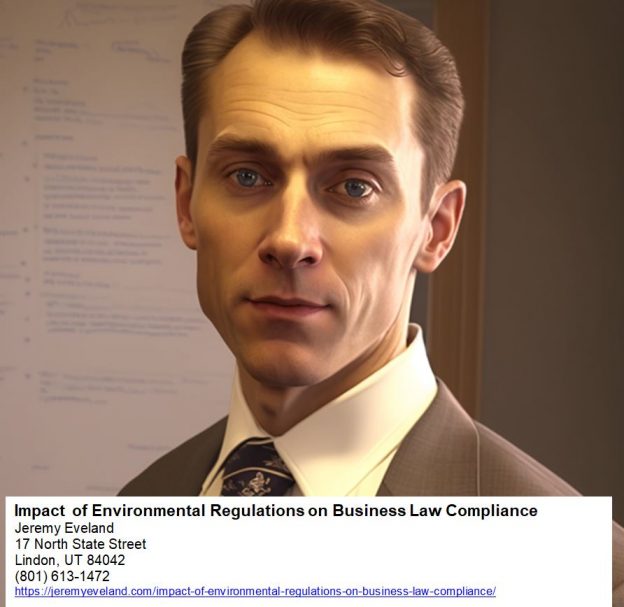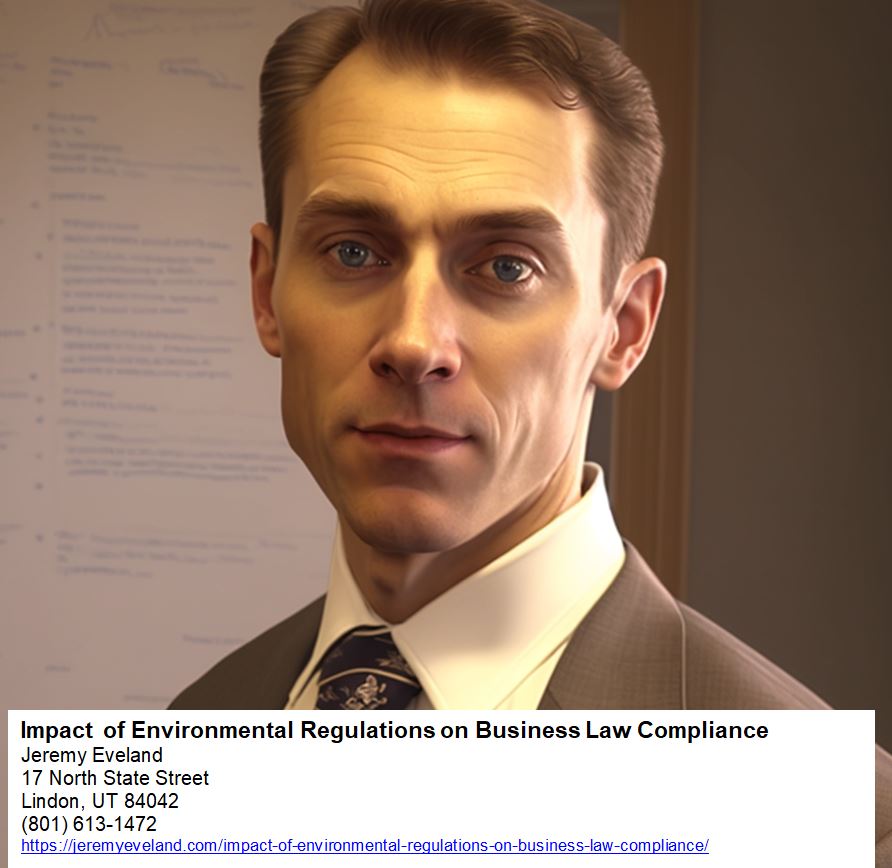In the complex world of business law, navigating through the intricacies of environmental regulation is of utmost importance. Whether you are a small startup or a well-established corporation, understanding and complying with environmental regulations is crucial to ensure sustainable and responsible operations. This article aims to provide you with comprehensive insights into the realm of environmental regulation, highlighting its significance and the potential legal ramifications of non-compliance. By delving into key topics such as permits, compliance strategies, and enforcement mechanisms, we will equip you with the knowledge needed to make informed decisions that align with both legal requirements and environmental stewardship. At the end of this article, you will find five commonly asked questions accompanied by concise answers, empowering you to proactively address any concerns you may have.
Overview of Environmental Regulation
Definition and Scope
Environmental regulation refers to a set of rules and laws implemented by governmental bodies to protect the environment and address issues related to pollution, resource conservation, and ecological sustainability. These regulations aim to guide individuals, businesses, and industries in minimizing their negative impact on the environment and promoting responsible practices.
The scope of environmental regulation encompasses various aspects, including air and water quality control, waste management, energy efficiency, and the use of toxic substances. It involves setting standards, monitoring compliance, and enforcing penalties for non-compliance to ensure the protection and preservation of the environment for current and future generations.
Importance of Environmental Regulation
Environmental regulation plays a crucial role in safeguarding the well-being of both humans and ecosystems. It helps prevent or reduce pollution, minimize health risks, conserve natural resources, and preserve biodiversity. By setting standards, environmental regulation ensures that industries adopt sustainable practices and mitigate the potential harm caused by their operations.
Moreover, environmental regulation provides certainty and predictability for businesses. By establishing clear rules and guidelines, companies can make informed decisions regarding their operations, investments, and risk management. Adhering to environmental regulations also enhances a company’s reputation, improves public trust, and promotes long-term business sustainability.
Additionally, environmental regulation promotes innovation and the development of cleaner technologies. It incentivizes industries to invest in research and development to find efficient and eco-friendly alternatives, further driving economic growth and job creation.
History of Environmental Regulation
Early Environmental Protection Efforts
The need for environmental regulation became evident during the Industrial Revolution, when rapid industrialization led to widespread pollution and degradation of the environment. In response to the detrimental effects of unchecked industrial activities, governments around the world started taking measures to protect the environment.
Early environmental protection efforts included the establishment of national parks and protected areas to safeguard pristine ecosystems and natural resources. In the United States, the creation of Yellowstone National Park in 1872 marked the first step towards government-led conservation efforts.
Key Environmental Regulations
Throughout history, several key environmental regulations have been enacted to address specific environmental issues and concerns. These regulations have shaped the environmental regulatory landscape and influenced sustainable practices globally.
One significant regulation is the Clean Air Act (CAA). Enacted in the United States in 1970, the CAA aims to regulate air pollutants, improve air quality, and mitigate the impacts of air pollution on human health and the environment. It sets standards for emissions from industries, vehicles, and other sources and establishes mechanisms for monitoring and enforcing compliance.
The Clean Water Act (CWA), enacted in 1972, is another critical environmental regulation. It focuses on regulating the discharge of pollutants into navigable waters and protecting water quality. The CWA established the framework for maintaining the integrity of water bodies, protecting aquatic life, and ensuring safe drinking water.
The Resource Conservation and Recovery Act (RCRA) was enacted in 1976 to manage the generation, transportation, treatment, storage, and disposal of hazardous waste. It establishes strict regulations to minimize the risk posed by hazardous waste to human health and the environment and promotes the proper management of waste through various control measures.
Another significant environmental regulation is the National Environmental Policy Act (NEPA), passed in 1969. NEPA established the framework for assessing and minimizing the environmental impacts of federal projects and actions. It requires federal agencies to evaluate the environmental consequences of their activities and involve the public in the decision-making process.

Key Agencies and Laws
Environmental Protection Agency (EPA)
The Environmental Protection Agency (EPA) is a prominent federal agency responsible for implementing and enforcing various environmental regulations in the United States. Established in 1970, the EPA works to protect human health and the environment by enforcing laws such as the Clean Air Act, Clean Water Act, and RCRA.
The EPA conducts research, monitors environmental quality, develops regulations, and provides guidance to industries and individuals. It plays a vital role in assessing and addressing environmental issues and ensuring compliance with environmental regulations across the country.
Clean Air Act (CAA)
The Clean Air Act (CAA) is a federal law aimed at improving air quality and reducing air pollution in the United States. Enacted in 1970, the CAA empowers the EPA to establish and enforce regulations to control the emissions of harmful pollutants from various sources.
The CAA sets national ambient air quality standards (NAAQS) for pollutants such as ozone, particulate matter, carbon monoxide, nitrogen oxides, and lead. It also provides guidelines for implementing emission control technologies, promoting clean energy alternatives, and enhancing the overall air quality.
Clean Water Act (CWA)
The Clean Water Act (CWA) is a federal law that regulates the discharge of pollutants into navigable waters and protects water quality in the United States. Enacted in 1972, the CWA establishes a framework for water pollution control, wetlands conservation, and safe drinking water.
The CWA requires permits for discharging pollutants into water bodies and sets water quality criteria to protect aquatic life and human health. It also promotes the restoration and protection of wetlands, which are crucial ecosystems that provide numerous ecological benefits.
Resource Conservation and Recovery Act (RCRA)
The Resource Conservation and Recovery Act (RCRA) is a federal law that governs the management of hazardous waste from its generation to its disposal. Enacted in 1976, the RCRA aims to protect human health and the environment from the risks associated with hazardous waste.
The RCRA establishes comprehensive regulations for the proper handling, storage, treatment, and disposal of hazardous waste. It requires waste generators to obtain permits, implement waste reduction measures, and comply with stringent standards to ensure the safe management of hazardous materials.
National Environmental Policy Act (NEPA)
The National Environmental Policy Act (NEPA) is a federal law that promotes environmental stewardship and enhances public participation in federal decision-making processes. Enacted in 1969, NEPA mandates federal agencies to consider and disclose the potential environmental impacts of their actions.
NEPA requires federal agencies to prepare environmental impact statements (EIS) for significant projects that may impact the environment. The EIS assesses the environmental consequences of proposed actions, identifies alternatives, and provides opportunities for public input. NEPA ensures that environmental concerns are integrated into the decision-making process and promotes transparency and accountability.
Environmental Impact Assessment
Purpose and Process
An Environmental Impact Assessment (EIA) is a systematic process used to evaluate the potential environmental, social, and economic impacts of a proposed development project or policy. The purpose of an EIA is to inform decision-makers about the potential consequences of their actions and explore alternatives to minimize adverse effects.
The EIA process typically involves the following steps:
- Scoping: Defining the boundaries, objectives, and key issues to be addressed in the assessment.
- Impact identification: Evaluating the potential environmental, social, and economic impacts of the project.
- Impact assessment: Quantifying and analyzing the identified impacts and their significance.
- Mitigation and alternatives: Identifying measures to reduce or mitigate adverse impacts and exploring alternative options.
- Reporting: Documenting the findings and recommendations in an Environmental Impact Statement (EIS) or Environmental Assessment (EA).
- Review and decision-making: Public and expert review of the EIS/EA, followed by a decision on the project’s approval or modification.
Components of an EIA
An EIA typically encompasses several components to comprehensively assess the potential impacts of a project. These components may include:
- Baseline assessment: Evaluating the existing environmental conditions in the project area before the proposed development.
- Impact prediction: Identifying and predicting the potential impacts of the project on various environmental factors, such as air quality, water resources, biodiversity, and socio-economic aspects.
- Cumulative impact assessment: Considering the combined effects of the proposed project with other past, present, and future actions in the area.
- Mitigation measures: Suggesting measures to avoid, minimize, or mitigate adverse impacts through alternative designs, technologies, or management practices.
- Monitoring and management plan: Establishing a framework for monitoring and managing the impacts during project implementation and operation.
Role of Stakeholders
Stakeholder involvement is a crucial aspect of the EIA process. Stakeholders are individuals or groups who may be affected by or have an interest in a proposed project. Their inclusion helps ensure that different perspectives, concerns, and values are considered in the decision-making process.
Stakeholders involved in the EIA process may include local communities, indigenous groups, non-governmental organizations, government agencies, and experts from various disciplines. Their participation can contribute valuable insights, local knowledge, and alternative viewpoints, promoting a more comprehensive and sustainable assessment of potential impacts.
Engaging stakeholders throughout the EIA process fosters transparency, trust, and accountability. It allows for meaningful public participation, providing affected communities and individuals the opportunity to voice their concerns, contribute to the decision-making process, and influence the final outcomes.

Air Quality Regulations
Sources of Air Pollution
Air pollution can originate from both natural and human activities. Natural sources include volcanic eruptions, wildfires, and dust storms. However, human activities are significant contributors to air pollution, with industries, transportation, power generation, and residential activities being major sources.
Industrial emissions, such as those from manufacturing processes, power plants, and chemical production, release pollutants such as sulfur dioxide, nitrogen oxides, volatile organic compounds (VOCs), and particulate matter into the atmosphere. Transportation, including cars, trucks, and airplanes, also emits pollutants such as carbon monoxide, nitrogen oxides, and particulate matter.
Residential activities such as the burning of solid fuels for cooking and heating, as well as the use of certain consumer products, can release pollutants such as carbon monoxide, particulate matter, and VOCs. Agricultural activities, including livestock farming and crop burning, can also contribute to air pollution.
National Ambient Air Quality Standards (NAAQS)
National Ambient Air Quality Standards (NAAQS) are regulatory standards established by the EPA to protect public health and the environment from harmful air pollutants. NAAQS set concentration limits for pollutants, including ozone, carbon monoxide, nitrogen dioxide, sulfur dioxide, lead, and particulate matter.
These standards define the maximum allowable levels of these pollutants in the outdoor air to ensure that they do not pose significant health risks to individuals, including sensitive groups such as children, the elderly, and those with respiratory conditions. Meeting NAAQS is crucial in maintaining air quality and reducing the harmful effects of air pollution on human health.
Control of Air Emissions
To control air emissions and ensure compliance with air quality standards, various measures and technologies are employed. These measures include:
- Emission controls: Industries and vehicles use technologies such as catalytic converters, scrubbers, and filters to reduce the release of pollutants into the air. These controls help remove or convert harmful substances before they are released into the atmosphere.
- Fuel regulations: Governments impose standards on the quality of fuels used in vehicles and industrial processes. These regulations aim to reduce the content of pollutants in fuels, thereby reducing emissions.
- Vehicle emission standards: Governments set regulations on vehicle emissions, requiring manufacturers to produce vehicles that meet specific emission limits. These standards promote the development and adoption of cleaner vehicle technologies.
- Renewable energy promotion: Encouraging the transition from fossil fuel-based energy generation to renewable sources, such as solar and wind power, reduces air pollution associated with fossil fuel combustion.
- Industrial best practices: Implementing best practices, such as energy-efficient operations, waste minimization, and responsible handling of chemicals, reduces the overall emissions of pollutants from industries.
Through these measures, countries can mitigate the negative effects of air pollution, improve public health, and work towards achieving sustainable air quality.
Water Quality Regulations
Water Pollution and its Impacts
Water pollution refers to the contamination of water bodies, such as lakes, rivers, oceans, and groundwater, leading to adverse impacts on aquatic ecosystems and human health. Pollution can result from various sources, including industrial discharges, inadequate wastewater treatment, agricultural runoff, and improper waste disposal.
The impacts of water pollution can be significant. Contaminated water can harm aquatic life, destroy ecosystems, reduce biodiversity, and impair habitats. It can also make water unsafe for human consumption, recreation, and agriculture, leading to waterborne diseases and economic losses.
Furthermore, polluted water can impact downstream communities and ecosystems, highlighting the interconnectedness of water bodies and the need for effective water quality regulations.
Water Quality Standards
Water quality standards are regulatory benchmarks established by government agencies to ensure the safety and integrity of water resources. These standards define the acceptable concentration levels of pollutants and establish guidelines for monitoring and maintaining water quality.
Water quality standards vary depending on the intended use of the water body, such as drinking water, recreational activities, or aquatic habitat preservation. Different parameters, such as pH, temperature, turbidity, dissolved oxygen, and the presence of specific pollutants, are considered when establishing these standards.
Compliance with water quality standards is crucial in safeguarding human health, preserving aquatic ecosystems, and ensuring the sustainability of water resources.
Water Pollution Control Measures
To prevent and mitigate water pollution, various control measures and regulations are in place. These measures include:
- Wastewater treatment: Industries, municipalities, and other entities are required to treat their wastewater before releasing it into water bodies. Treatment processes remove or reduce pollutants to acceptable levels, ensuring that discharged water meets water quality standards.
- Agricultural best practices: Implementing sustainable agriculture techniques, such as soil erosion control, responsible use of fertilizers and pesticides, and proper management of animal waste, minimizes the contamination of water bodies with agricultural runoff.
- Stormwater management: Urban areas often generate significant amounts of stormwater runoff, which can carry pollutants into water bodies. Proper stormwater management strategies, such as the use of retention ponds, permeable surfaces, and green infrastructure, help reduce the impact of runoff on water quality.
- Pollution prevention measures: Implementing pollution prevention programs focuses on reducing or eliminating the generation of pollutants at the source. These measures include cleaner production practices, waste management strategies, and education and outreach campaigns to promote responsible behavior.
- Monitoring and enforcement: Regular monitoring of water bodies and strict enforcement of regulations are essential to ensure compliance with water quality standards. Monitoring helps identify potential sources of pollution and evaluate the effectiveness of control measures. Enforcement actions, such as penalties for non-compliance, deter polluters and promote responsible practices.
Through these control measures, water quality regulations aim to protect the integrity of water resources, preserve aquatic ecosystems, and ensure the availability of safe and clean water for various uses.
Hazardous Waste Management
Definition and Classification of Hazardous Waste
Hazardous waste is any solid, liquid, or gaseous material that poses significant risks to human health, the environment, or both. It can be generated from industrial processes, commercial activities, household practices, or other sources.
Hazardous waste is classified based on its characteristics and properties. Common classifications include:
- Ignitable wastes: These wastes can easily catch fire, such as flammable liquids, solvents, or compressed gases.
- Corrosive wastes: These wastes are highly acidic or alkaline and can cause severe damage or destruction to living tissue or materials they come into contact with.
- Reactive wastes: These wastes are unstable and may cause explosions, reactions, or hazardous releases when exposed to certain conditions, such as heat, pressure, or contact with other substances.
- Toxic wastes: These wastes contain toxic substances that, even at low concentrations, can cause harm to human health or the environment.
The proper management of hazardous waste is essential to prevent accidents, pollution, and health risks associated with its improper handling, storage, transportation, and disposal.
Treatment and Disposal Options
To ensure the safe handling and disposal of hazardous waste, specific treatment and disposal options are employed. These options vary depending on the characteristics and properties of the waste.
Commonly used treatment methods include:
- Incineration: High-temperature incineration can destroy or convert hazardous waste into less harmful substances or ashes.
- Physical treatment: Techniques such as filtration, evaporation, and distillation are used to separate or concentrate hazardous components from the waste.
- Chemical treatment: Chemical processes, such as precipitation, oxidation, or reduction, are employed to neutralize or transform hazardous substances into less harmful forms.
- Biological treatment: Microorganisms are used to degrade or remove hazardous waste through processes such as composting, bioremediation, or detoxification.
Disposal options for hazardous waste include:
- Secure landfills: Hazardous waste is deposited in specially designed and engineered landfills with strict containment measures to prevent leaks or releases.
- Deep well injection: Some waste can be injected deep underground in designated wells while adhering to proper regulations and precautions.
- Treatment for beneficial use: Certain hazardous wastes can be treated to remove or reduce their hazardous properties, making them suitable for recycling or reuse in specific applications.
Regulatory Compliance
Regulatory agencies enforce stringent requirements and standards to ensure proper hazardous waste management. Compliance with these regulations involves:
- Identifying and characterizing hazardous waste: Proper identification, categorization, and characterization of hazardous waste, including accurate labeling, is crucial to ensure proper handling and disposal.
- Obtaining necessary permits: Facilities that generate, transport, store, or dispose of hazardous waste may need permits or authorizations from regulatory agencies.
- Implementing waste minimization: Waste minimization practices, such as pollution prevention, source reduction, and recycling, should be adopted to minimize the generation of hazardous waste.
- Proper storage and transportation: Secure storage facilities and appropriate transportation containers should be used to prevent leaks, spills, or accidents during handling and transportation.
- Record-keeping and reporting obligations: Facilities must maintain comprehensive records and reports to demonstrate compliance with regulatory requirements and enable effective monitoring and enforcement.
Complying with hazardous waste regulations is essential to protect human health, prevent environmental pollution, and avoid legal liabilities and penalties.
Toxic Substances Control
Toxic Substances and their Risks
Toxic substances are chemical or biological agents that can cause harm to human health or the environment. These substances can be found in various products, materials, or waste streams and may have acute or chronic toxic effects.
Exposure to toxic substances can occur through inhalation, ingestion, or contact with the skin. They can cause immediate harm or have long-term health effects, such as cancer, reproductive disorders, neurological damage, or respiratory ailments.
Assessing and managing the risks associated with toxic substances is crucial to protect human health and the environment and ensure the safe use and disposal of these materials.
Toxic Substances Control Act (TSCA)
The Toxic Substances Control Act (TSCA) is a federal law enacted in 1976 to regulate the manufacture, distribution, importation, and use of chemicals in the United States. The TSCA provides the Environmental Protection Agency (EPA) with the authority to assess and control the risks associated with toxic substances.
Under the TSCA, the EPA can require manufacturers, processors, and distributors to provide data on the production, use, and potential hazards of chemicals. The EPA can also restrict or ban the manufacture or use of substances that pose unreasonable risks to human health or the environment.
The TSCA aims to ensure the safety of chemicals, promote the development and use of safer alternatives, and provide regulatory oversight for the introduction of new chemicals into the market.
Chemical Safety Improvement Act (CSIA)
The Chemical Safety Improvement Act (CSIA) is proposed legislation that seeks to modernize and strengthen the regulation of chemicals in the United States. The CSIA aims to update the Toxic Substances Control Act (TSCA) by enhancing the EPA’s authority to assess and manage the risks associated with chemicals.
The CSIA proposes a risk-based approach to chemical regulation, requiring manufacturers to demonstrate the safety of their products and providing the EPA with increased authority to regulate new and existing chemicals. It also promotes transparency, public participation, and collaboration among stakeholders in the regulation of chemicals.
If enacted, the CSIA would enhance consumer confidence in the safety of chemicals, encourage the development of safer alternatives, and contribute to the protection of human health and the environment.

Energy Efficiency and Conservation
Importance of Energy Efficiency
Energy efficiency refers to the practice of using less energy to accomplish the same tasks or achieve the same level of output. It involves optimizing energy use, reducing waste, and incorporating energy-saving technologies and practices.
Energy efficiency is essential for several reasons:
- Environmental protection: Improving energy efficiency reduces the demand for energy, thereby mitigating the environmental impacts associated with energy production and consumption. It helps reduce greenhouse gas emissions, air pollution, and the depletion of natural resources.
- Energy security: Enhancing energy efficiency reduces dependence on fossil fuels and decreases vulnerability to energy supply disruptions. It promotes energy diversification, stimulates local economies, and enhances energy resilience.
- Cost savings: Energy-efficient practices and technologies can significantly reduce energy consumption and lower energy bills for individuals, businesses, and governments. It enables cost savings that can be redirected to other productive activities.
- Economic growth: Energy efficiency drives economic growth by stimulating innovation, creating jobs, and enhancing productivity. Improvements in energy efficiency can spur the development of new technologies, industries, and markets, contributing to sustainable economic prosperity.
Energy Conservation Measures
Energy conservation refers to the practice of reducing energy consumption through behavioral changes, lifestyle choices, and operational adjustments. It involves using energy wisely, minimizing waste, and adopting sustainable habits.
Key energy conservation measures include:
- Efficient lighting: Switching to energy-efficient light bulbs, such as Light Emitting Diodes (LEDs), can significantly reduce electricity consumption for lighting.
- Heating and cooling optimization: Proper insulation, regular maintenance of heating, ventilation, and air conditioning (HVAC) systems, and adopting smart thermostats can reduce energy use for temperature control.
- Appliance efficiency: Choosing energy-efficient appliances, such as refrigerators, washing machines, and dishwashers, helps reduce electricity consumption in households.
- Building design and insulation: Designing buildings with energy-efficient features, such as high-performance insulation, proper orientation, and efficient windows, minimizes the need for heating, cooling, and lighting.
- Energy management systems: Using intelligent energy management systems and controls allows for the optimization of energy use, load balancing, and demand response.
- Transportation choices: Opting for public transportation, carpooling, biking, or walking reduces fuel consumption and greenhouse gas emissions.
- Behavioral changes: Promoting awareness and education about energy conservation encourages individuals and communities to adopt energy-saving practices, such as turning off lights when not in use, unplugging electronics, and reducing water heating temperatures.
By implementing energy conservation measures, individuals, businesses, and governments can contribute to energy sustainability, reduce environmental impacts, and achieve cost savings.
Government Initiatives
Governments play a crucial role in promoting energy efficiency and conservation through policy frameworks, incentives, and regulations. Governments at the national, state, and local levels can implement the following initiatives:
- Energy efficiency standards: Governments can enforce efficiency standards for appliances, vehicles, and buildings to ensure that only energy-efficient options are available in the market.
- Incentive programs: Governments can offer financial incentives, such as tax credits or rebates, to individuals and businesses that adopt energy-efficient technologies or implement energy conservation measures.
- Energy labeling and certification: Governments can require products and buildings to carry energy labels or certifications that inform consumers about their energy efficiency and help them make informed choices.
- Building codes and regulations: Governments can establish and enforce energy-efficient building codes and regulations that set minimum requirements for new construction and renovations.
- Research and development funding: Governments can invest in research and development programs to support the development of innovative energy-efficient technologies and practices.
- Public transportation and infrastructure: Governments can invest in public transportation systems, infrastructure for electric vehicles, and cycling and pedestrian-friendly initiatives to reduce reliance on private vehicles and promote sustainable transportation options.
- Public awareness campaigns: Governments can launch public awareness campaigns to educate citizens about the importance of energy efficiency and conservation and promote behavior change.
Through these initiatives, governments can drive the adoption of energy-efficient practices, create green jobs, and accelerate the transition to a sustainable and low-carbon future.
Enforcement and Compliance
Enforcement Mechanisms
Enforcement of environmental regulations is essential to ensure compliance and deter non-compliant behavior. Regulatory agencies have various mechanisms to enforce environmental laws and regulations, including:
- Inspections and audits: Regulatory agencies conduct routine or surprise inspections and audits to assess compliance with environmental regulations. Inspectors verify whether operations, waste management practices, emissions, or water discharges meet regulatory standards.
- Compliance assistance and education: Regulatory agencies provide guidance and educational materials to help businesses and individuals understand and comply with environmental regulations. Compliance assistance programs offer resources, workshops, and training to promote voluntary compliance.
- Monitoring and reporting requirements: Regulatory agencies require facilities to monitor and report their emissions, discharges, waste management, or other relevant data regularly. By monitoring compliance data, regulatory agencies can identify non-compliant activities and take appropriate enforcement actions.
- Administrative orders: Regulatory agencies can issue administrative orders, such as notices of violation or cease and desist orders, to enforce compliance or correct non-compliant behavior. These orders may include instructions to remediate, pay fines, or make necessary changes to ensure compliance.
- Civil penalties and fines: Non-compliance with environmental regulations can lead to financial penalties or fines. Regulatory agencies can impose monetary sanctions to deter non-compliant behavior and compensate for damage caused by the violation.
- Criminal prosecution: In severe cases of non-compliance, such as deliberate pollution or illegal disposal of hazardous waste, regulatory agencies can refer cases for criminal prosecution. Criminal charges can lead to penalties, imprisonment, or other legal consequences.
- Revocation or suspension of permits: Regulatory agencies have the power to revoke or suspend permits or licenses of non-compliant facilities. This action prohibits the operation or forces the closure of facilities until compliance is achieved.
By using these enforcement mechanisms, regulatory agencies can promote compliance, deter non-compliance, and protect the environment.
Penalties for Non-Compliance
Non-compliance with environmental regulations can result in significant penalties, fines, legal liabilities, and reputational damage for individuals and businesses. Penalties vary depending on the severity of the violation, the environmental harm caused, and the relevant regulations.
Penalties for non-compliance may include:
- Civil penalties: Regulatory agencies can impose civil fines for violations of environmental regulations. These penalties can range from a few hundred dollars to several thousand dollars per violation, depending on the jurisdiction and the nature of the violation.
- Criminal penalties: In cases of deliberate non-compliance, such as illegal dumping of hazardous waste, criminal charges can lead to imprisonment, hefty fines, or both.
- Legal liabilities: Non-compliance can result in legal liabilities, including lawsuits, clean-up costs, compensation claims, or property damage. Violators may be held financially accountable for the harm caused by their non-compliant actions.
- Regulatory action: Regulatory agencies can take various actions, including suspending or revoking permits, issuing stop-work orders, or ordering the remediation of environmental damage caused by non-compliance.
To avoid the consequences of non-compliance, it is crucial for individuals and businesses to understand and adhere to environmental regulations and adopt responsible practices.
Compliance Strategies
Achieving and maintaining compliance with environmental regulations requires proactive efforts and commitment. To ensure compliance, individuals and businesses can adopt the following strategies:
- Knowledge and awareness: Stay informed about relevant environmental regulations, standards, and best practices. Engage in continuous education and training to enhance understanding of compliance requirements.
- Regulatory compliance programs: Develop internal compliance programs that outline responsibilities, procedures, and protocols for achieving and maintaining compliance. These programs should include regular auditing, self-assessment, and record-keeping to track compliance.
- Partnerships and collaborations: Collaborate with industry associations, consultants, and other experts to gain insights into compliance strategies specific to your sector. Networking with peers can help identify best practices and share lessons learned.
- Implementation of management systems: Implement environmental management systems, such as ISO 14001, to ensure that environmental compliance is integrated into organizational processes and decision-making. These systems provide a structured framework for managing compliance risks.
- Regular monitoring and self-assessment: Conduct regular monitoring of operations, emissions, waste management, or other relevant parameters to proactively identify non-compliance issues. Perform regular self-assessments to identify gaps, develop corrective actions, and continuously improve compliance performance.
- Employee training and engagement: Train and educate employees on environmental compliance requirements and their roles and responsibilities in achieving compliance. Foster a culture of environmental stewardship and empower employees to report potential non-compliance or suggest improvements.
- External expertise: Seek guidance from environmental consultants or lawyers specializing in environmental law to ensure compliance with complex regulations. Legal professionals can assist in interpreting requirements, navigating permitting processes, and resolving compliance-related issues.
By employing these compliance strategies, individuals and businesses can mitigate risks, ensure environmental responsibility, and build a reputation for sustainability and ethical practices.

